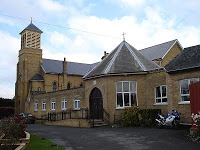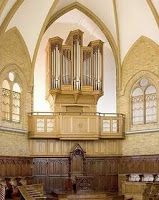It has been my great privilege to pay a number of recent visits to the Abbey of St Cecilia in Ryde on the Isle of Wight, just off the south coast of England UK Academy of St Cecilia , when Professor John Caldwell of Oxford University

The Abbey has an interesting history in that the nuns were originally members of the community of the Abbaye Sainte- Cécile de Solesmes. The French anti religious laws of the early 20th century forced the whole community into exile in England
The sisters sing the entire Office and Mass to Gregorian Chant every day of the year. A visiting monk from Quarr Abbey, a few miles away on the same island, makes a daily trip to celebrate the Mass (Novus Ordo in Latin) and the Monastic Choir, under the direction of Sr Bernadette, a true disciple of Dom Cardine, trains the sisters on a regular basis in the Chants of the Office and the Mass, using Cardine’s Semiological approach. This, coupled with the use of Dom Saulnier’s new Antiphonale Monasticum, now fully in use in the Abbey, makes for the most vibrant, fluid and prayerful performance of the Chant I have heard in the UK

The Abbey also boats a new Kenneth Tickell organ in the West End of the Monastic Choir – details of which, for all organ enthusiasts, can be seen at www.tickellorgans.co.uk/specInfo/opus54.htm. The Community can be visited at any time and has an excellent website – www.stceciliasabbey.org.uk – and I urge those of you who live in or are visiting the south of England to make a short trip across the Solent by hovercraft, ferry or catamaran, to hear the mesmeric singing of this wonderful, young, thriving, growing community of nuns.
Nick Gale, June 2010

I just received the following from Sr Eustochium of Ryde:
One point of fact which I should correct: we are not a direct descendant of the nuns of Ste Cecile de Solesmes who built our present Abbey (whereas the present community of monks at Quarr is a continuation of the colony left behind when the monks of S Pierre de Solesmes returned to France). Our community was founded on the Isle of Wight in 1882 by the Abbey of Paix Notre Dame, Liege, Belgium. The anti-clerical movement which drove out the Solesmes monks and nuns in 1902 was one part of decades of anti-clericalism in Europe. There was a wonderful episode in France in 1880 under which the monks of Solesmes were forcibly expelled from their own monastery – dragged from the choir-stalls, as the monks had decided not to resist but not to co-operate either – and though allowed to remain nearby were not allowed back into the abbey for years. There were similar rumblings at the time in Belgium and so the nuns of Liege decided to open a small house in England which would of course be for the increase of God's praises but might also serve as a bolt-hole if the whole community had to leave. This little community had been at Ventnor on the Isle of Wight for more than 20 years when the French monks and nuns arrived, and so was able to help them in many ways. In return, the Abbot of Solesmes, Dom Delatte, arranged for the famous Dom Mocquereau to give us chant lessons. At this time our community was gradually evolving into a fully enclosed, contemplative monastery, and the advice and example of the Solesmes monks and nuns was a great influence and encouragement. When the Solesmes communities returned to France, the nuns of Ste Cecile let us have these buildings. In 1950 we were aggregated to the Solesmes Congregation. We are proud to be part of it, but cannot claim the honour of being directly derived from Solesmes.